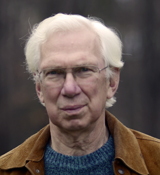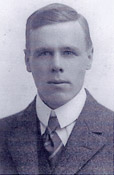Lightyears Collection
Bint El Sudan
W.J. Bush & Co.
(1920)
NOTE: When I first acquired a bottle of Bint El Sudan, I knew nothing of its history and wrote my article based on a small knowledge of W.J. Bush & Co. and some surmised about this perfume. Some time after the first version of my story appeared, I was contacted by Mr. Tony Bate, grandson of Eric Burgess, a W.J. Bush & Co. salesman for 50 years and the "instigator" of Bint El Sudan. Mr. Bate provided me with some fascinating information about his grandfather — and the history of Bint El Sudan — which I have used to revise this article.
The story of Bint El Sudan perfume starts with a young Englishman, Eric Burgess (1891-1977) who, at the age of 16, joined the firm of W.J. Bush & Co. where his father was to become a director. Starting as a "tea boy" (gofer), Eric Burgess soon became a commission salesman. Having been educated in Geneva where the family had a home, Burgess had gained a reputation for fluency in languages. W.J. Bush & Co. made good use of this talent by sending him to foreign lands. Between 1919 and 1920, Eric Burgess found himself in the Sudan. The story that follows appears to have been told by Burgess himself in several versions. The basic outline is as follows: One blazingly hot day in Khartoum, a band of men "looking like brigands from Omdurman" crowed into the small office of W.J. Bush & Co's local representative. After squatting on the floor and serving tea, they produced a number of vials of exotic fragrance materials. Their desire was to have them made into a perfume. Burgess delivered these vials to the W.J. Bush & Co. laboratories where they were blended into a fragrance — that was too costly for the market! Substitutions were made and a sensible price point was achieved. Bint El Sudan was born! Introduced in 1920, Bint El Sudan became an amazing hit with its fame spreading east across Africa and west across the Arab Middle East. In keeping with the prohibition enforced by some Muslims, Bint El Sudan was manufactured without alcohol. It's heavy aroma never found favor in Europe but, in the warmer climates where stronger fragrances were favored, Bint El Sudan became a runaway best seller. In time it became the world's best selling, non alcoholic perfume and as recently as the early 1970's, some claim that Bint El Sudan was the world's best selling perfume without exception. The name Bint El Sudan and the artwork on the bottle are closely connected. "Bint" is Arabic for "daughter" or "maiden" — hence "Bint El Sudan" becomes "Daughter of Sudan", "Sudanese Maiden" or "Sudanese Girl". As to the young woman on the bottle, the artwork was prepared from a photograph Burgess, an amateur photographer, had taken of three Sudanese teenagers (princesses, according to Burgess family tradition) clothed in elephant hair skirts. The fame of Bint El Sudan became such that it drew counterfeiters who sometimes substituted kerosene for the genuine fragrance. Eric Burgess himself was personally responsible for crackdowns on counterfeiters who, when caught in a British territory, were likely to find themselves jailed. Today replicas of Bint El Sudan perfume oil are widely available on the internet. In 1961, W.J. Bush & Co. was sold to Albright & Wilson. In 1966, Albright & Wilson sold it and it became the "Bush" in Bush Boake Allen which, in 2000, became part of International Flavors & Fragrances (IFF).
|
|
If you have any comments you would like to add about Bint El Sudan or W.J. Bush & Co., please share them with us using the message sender below. |
|


Philip Goutell
Lightyears, Inc.







